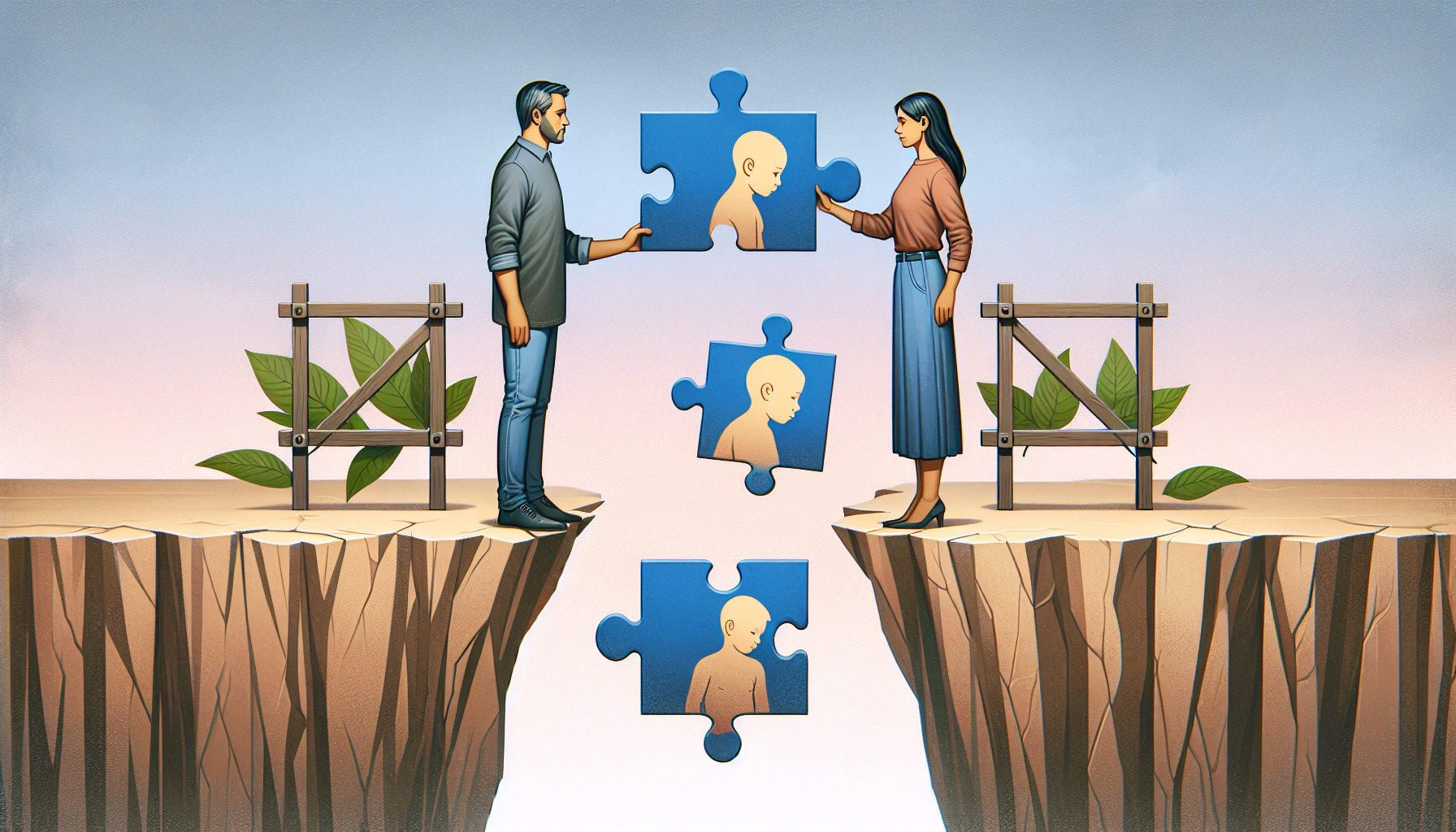Imago couples therapy directly targets the heart of relational challenges—communication breakdowns and unresolved emotional wounds from our past. By examining these underlying issues, this unique therapy model aims to reconstruct the way partners interact with one another, fostering healthy, empathic connection. Learn how navigating through this process can rejuvenate your relationship.
Key Takeaways
- Imago Couples Therapy, developed by Harville Hendrix and Helen LaKelly Hunt, is designed to help partners understand and heal each other by transforming subconscious relationship patterns established in childhood into conscious, healing interactions.
- Central to Imago Therapy is the Imago Dialogue, a technique incorporating specific communication roles and mirroring exercises to foster empathy, enhance intimacy, and create emotional safety, allowing partners to express and understand feelings without judgment.
- Imago Therapy’s applicability extends across various relationship stages and settings—from premarital preparation to rekindling intimacy in longstanding relationships, and even to family and professional contexts—by improving communication and fostering empathetic connections.
Exploring the Core Principles of Imago Couples Therapy
Imago Couples Therapy, also known as Imago Relationships, is the beacon that shines light on the often-subconscious relationship patterns that govern our adult relationships. At its heart lies the term ‘Imago,’ an unconscious image of familiar love sculpted in the foundry of early childhood experiences. These foundational years, under the influence and care of our primary caregivers, craft an internal blueprint that guides our affections and attachment behaviors later in life. It’s a fascinating revelation that the love dynamics we observed and internalized as children create a magnetic pull towards partners who echo these early relational dances.
Developed by the insightful work of Harville Hendrix, PhD, and Helen LaKelly Hunt, PhD, Imago Relationship Therapy (IRT) builds a bridge between academic research and personal insights, providing a structured pathway towards understanding the core issues that surface in intimate relationships. It’s not just about navigating the choppy waters of coupledom; it’s about setting sail towards a conscious relationship grounded in mutual healing and growth.
The Role of the Imago Dialogue in Couples Therapy
At the nexus of Imago therapy is the Imago Dialogue, a transformative technique that employs intentional communication to foster a deeper understanding between partners. This isn’t your run-of-the-mill conversation; it’s a dialogue process meticulously designed to restructure how couples engage with each other, promoting a shift from reactive exchanges to a language of empathy and connection. Imagine transforming the minefield of relationship issues into a sanctuary where every word is a stepping stone towards intimacy and understanding.
Guided by the hands of trained imago therapists, couples are led through therapy sessions that gently peel away layers of harmful communication habits, creating a safe environment that supports emotional safety and lays the groundwork for healing even the most deep-seated childhood wounds. The Imago Dialogue isn’t just about improving communication; it’s a vessel that carries partners towards the shores of a conscious relationship, where each voice is heard and every emotion is validated.
The Sender and Receiver Dynamics
In the intricate dance of the Imago Dialogue, two roles emerge: the ‘sender,’ who communicates with openness and vulnerability, and the ‘receiver,’ who embodies the essence of mirroring, validation, and empathy. Picture the sender, armed with ‘I’ statements and a calm demeanor, delicately crafting messages that are free from blame and ripe for understanding. The receiver, on the other side, is the bastion of safety, offering a space where the sender’s words are not just heard but truly felt.
This interplay creates a cocoon that envelops the sender’s emotional expression, providing a judgment-free zone where genuine connection flourishes. It’s a delicate balance where each partner alternates between sharing and receiving, ensuring that the dialogue process remains a healing and growth-filled experience.
Fostering Empathy Through Mirroring
Mirroring, a cornerstone of Imago therapy techniques, acts as a mirror to the soul, reflecting a partner’s thoughts and feelings with the goal of fostering understanding and empathy. As the receiver echoes the sender’s message, often word for word, a bridge is built, one that spans the divide of misinterpretation and paves the way to a deeper and loving connection. It is a delicate art that requires the receiver to set aside their own perspectives and judgments, focusing solely on the other’s feelings and experiences.
By envisioning the sender as a wounded child, empathy blossoms, allowing the receiver to perceive the familiar strains of childhood survival patterns woven into the present dialogue. And as the receiver invites further exploration, asking questions to delve deeper into the sender’s psyche, they unearth layers of emotion and understanding that might have otherwise remained buried.
Mirroring, then, is not just a technique; it’s a pathway to facilitate healing, creating a safe environment where both partners can share openly and authentically.
Validation and Empathy: The Path to Intimacy
To validate in the Imago Dialogue is to acknowledge the sensibility of a partner’s perspective, to say, “Your feelings make sense from where you stand,” without necessarily sharing the same viewpoint. It’s about offering phrases like ‘That makes sense because…’ or ‘I can understand that given…’ as olive branches of understanding, even when the roots of agreement are not shared. Empathy stretches this gesture further, inviting an emotional connection that serves as a cornerstone for a romantic relationship that thrives on a deeper level. Interestingly, the term “imago” itself is a Latin word, which adds a historical touch to this dialogue technique.
Imagine the receiver articulating, ‘I can imagine that makes you feel…’, thereby stepping into the emotional shoes of the sender and sharing a moment of profound connection. Such empathetic engagements transform the relationship dynamic, carving out a space where vulnerability is not just accepted but cherished, and where trust and a loving connection are the fruits of openness and reduced defensiveness.
Validation and empathy are not mere words; they are the brushstrokes that paint a picture of intimacy, crafting a relationship where every emotion is not just heard but deeply felt. In early relationships, these aspects are crucial for building a strong foundation.
Imago Therapy for Different Relationship Stages
Imago therapy is not a one-size-fits-all approach; it is artfully tailored to resonate with couples at different stages of their journey together. Premarital couples find in Imago a toolset for laying the foundation of a healthy future marriage, equipping them to navigate communication issues and manage conflict from the outset.
Established couples, on the other hand, use Imago to:
- Stoke the flames of intimacy
- Turn marital burnout into a rekindled fire that satisfies emotional, physical, and intellectual needs collaboratively
- Guide couples trapped in the cyclical maze of repetitive conflict
- Help them unearth the roots of their disputes
- Chart a course towards resolution and a shared vision for their partnership
The Imago Dialogue shines brightest in these situations.
Whether it’s preparing for the altar or reigniting the spark in a committed relationship, Imago therapy offers a beacon of hope, illuminating the path to a fulfilling and conscious union.
The Therapeutic Journey with a Trained Imago Therapist
Embarking on the therapeutic journey with a trained Imago therapist is akin to navigating the depths of your relationship with a skilled cartographer. Creating a safe environment is paramount, where safety agreements rooted in mutual respect and love pave the way for couples to constructively address strong emotions and build trust. The therapist’s role transcends that of a mere guide; they are facilitators who shape the dialogue to align with each couple’s unique dynamic, never dictating the course but always illuminating the way.
During these sessions, couples delve into a variety of activities, including:
- Airing grievances
- Exploring childhood wounds
- Practicing the transformative Imago Dialogue and other techniques that sow the seeds of mutual healing and growth
With homework often assigned to reinforce in-session practices, the journey with an Imago therapist is one of discovery, where couples learn to recognize their relational patterns and reactions, thus empowering them to make more conscious choices in their own relationship.
Healing Childhood Wounds in Adult Life Through Imago
The heart of Imago therapy beats to the rhythm of connection—not just between partners, but between the past and the present. It makes a compelling link between the frustrations we face in our adult life and the tapestry of our early childhood experiences, shedding light on the survival patterns that were woven as coping mechanisms in response to unmet needs. The Imago Dialogue, with its structured format, serves as the canvas on which partners paint the stories of their early life, addressing the deeper emotional triggers and underlying issues that underpin surface problems.
Emotional safety, amplified by empathy within the Imago Dialogue, and a willingness to change behaviors, lay the foundation for a therapeutic process where individuals can confront their defense mechanisms developed to protect against earlier pain and fear. Through Imago therapy, individuals re-image themselves and their partners, recognizing conflict and distress as avenues to healing, allowing them to embrace the wounded child within and move toward recovery and wholeness.
The Scientific Research Behind Imago Therapy
Empirical evidence offers a compelling narrative for the efficacy of Imago therapy. A randomized controlled trial published in the Journal of Couple & Relationship Therapy reported that participants receiving Imago Relationship Therapy witnessed statistically significant increases in marital satisfaction compared to a control group, underscoring the potential of this therapeutic approach. However, the journey of marital satisfaction is not a linear one; while satisfaction levels post-treatment dipped slightly, they remained higher than before the intervention, hinting at the lasting impact of Imago on couples’ lives.
The study among married men in Isfahan revealed that Imago therapy not only improved marital satisfaction but also nurtured positive emotional experiences, simultaneously diminishing negative emotions towards spouses. Despite these promising results, the clinical significance at the dyad level was limited, with recovery achieved in a single couple, suggesting that Imago therapy’s impact warrants a broader, more in-depth investigation to determine its statistical and clinical significance. The Enrich Marital Satisfaction Scale, with its high reliability, served as a tool in this scientific quest, highlighting the need for ongoing research to fully comprehend the transformative power of Imago.
The Impact of Imago Therapy Beyond Romantic Relationships
Imago therapy’s influence extends far beyond the realm of romantic love, into the intricate dynamics of family life and the professional sphere. In families, Imago serves as a compass, guiding members through the murky waters of negative, repetitive issues and illuminating the cycles that perpetuate problems and unmet needs. It’s a therapeutic approach that not only quells the fires of conflict but also nurtures the seeds of intimacy, weaving a tighter, more intimate fabric among family members.
The workplace, too, can be transformed by the principles of Imago therapy, as it fosters empathetic communication and understanding among colleagues, contributing to a work environment that values and respects individual experiences. Whether dealing with the complexities of blended family dynamics, the challenges of empty nest syndrome, or the intricacies of professional relationships, Imago therapy offers tools for improving communication and fostering closer connections.
How to Cultivate a Conscious Relationship with Imago Techniques
Embarking on the path to a conscious relationship with Imago techniques is a journey of transformation. It requires a shift in perspective, a dismantling of expectations shaped by past experiences, and a rebuilding of attitudes towards love. The Imago Dialogue, with its power to slow down and space out conversations, acts as a mediator, breaking the usual patterns of communication and creating moments for both partners to engage in a dialogue that is free from the usual interruptions and interferences.
Conflicts, often seen as daunting obstacles, are reframed as opportunities for growth within the realm of Imago therapy. By using the Imago Dialogue, couples consciously seek to set aside time to discuss issues, turning potential rifts into rich soil for nurturing real love through daily acts of love.
A conscious relationship, then, is not a mere chance occurrence; it’s the product of deliberate actions and choices in committed relationships, guided by the principles of Imago therapy, to become the partner who fulfills the other’s needs and desires.
Summary
As we journey through the Imago landscape, we discover that the threads of our relationships are woven not only by the hands of fate but also by the patterns etched in our earliest memories. Imago Couples Therapy offers a map to navigate these terrains, where communication is not just about words but about creating a space where empathy, validation, and understanding flourish. It’s about turning conflicts into opportunities for growth and seeing our partners not just as they are but as the embodiment of both their and our own childhood dreams and wounds.
This journey is not without its challenges, and while the scientific research on Imago provides a beacon of empirical support, it reminds us that the path to a conscious relationship is a continuous one. The impact of Imago extends beyond romantic partnerships, offering a healing touch to family and professional relationships alike, proving that when it comes to the heart, the language of Imago is universal. May this guide inspire you to look within and beside you, to build bridges of connection that span the vast expanse of the human experience.























































